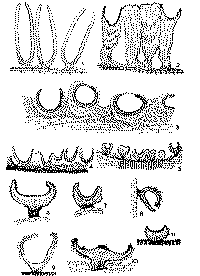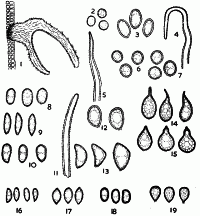|
 Flagelloscypha tongariro Flagelloscypha tongariro
SynonymsLachnella tongariro
Cyphella tongariro
BiostatusPresent in region - Indigenous. Endemic
Images (click to enlarge)
Caption: FIG. 9: Section through pileus of Cyphella tongariro. | 
Caption: FIG. 16: Spores of Cyphella tongariro. |
Article: Cooke, W.B. (1961). The cyphellaceous fungi. A study in the Porotheleaceae. Beihefte zur Sydowia 4: 144 p.
Description: Receptacles scattered, waxy, brittle, cupulate, 0,5-0,75 mm. in diameter, attached by a narrow
base; exterior white, tomentum composed of tortuous aseptate thick-walled branched hyphae,
5 µ in diameter, with lumen almost obliterated, coated with coarse deciduous crystals,
terminating in long, gradually tapering spirally coiled naked apices; margins inturned, lacerate
when old; hymenial surface concave, buff or honey-colored; context white, to 50 µ thick, to
500 µ at the base, of parallel radiately arranged hyphae; generative hyphae to 3,5 µ in
diameter, wall 0,25 µ thick, sparsely branched, septate; hymenial layer to 40 µ deep,
paraphyses subclavate ; basidia subclavate, 16-20 x 5-6 µ, 4-sterigmate; spores fusiform-elliptical,
apex rounded, base pointed and apiculate, 7-8 x 3-3,5 µ, smooth, hyaline.
Habitat: Habitat: On Phyllocladus trichomanoides.
Notes: The above description was taken from Cunningham (1953). The writer would add that the
basidia have basal clamps and some context hyphae are clamped. The surface hairs reach 150
µ long with the outer third of the whiplash type described above.
Article: Cunningham, G.H. (1948). New Zealand Polyporaceae. 3. The genus Polyporus. New Zealand Department of Scientific and Industrial Research, Plant Diseases Division, Bulletin 74: 39 p.
Description: Pilei annual; scattered, waxy, brittle, copulate, 0.5-0.75 mm. diameter, attached by a narrow
base; exterior white, tomentum composed of tortuous aseptate thick-walled branched hyphae,
5 µ diameter, with lumen almost obliterated, coated with coarse deciduous crystals,
terminating in long, gradually tapering spirally coiled naked apices; margins inturned, lacerate
when old; hymenial surface concave, buff or honey-coloured. Context white, to 50 µ thick, to
300 µ at the base, of parallel radiately arranged hyphae; generative hyphae to 3.5 µ diameter,
wall 0.25 µ thick, sparsely branched, septate. Hymenial layer to 40 µ deep, paraphyses
subclavate. Basidia subclavate, 16-20 x 5-6 µ, 4-spored. Spores fusiform-elliptical, apex
rounded, base pointed and apiculate, 7-8 x 3-3.5 µ, smooth, hyaline.
Habitat: HABITAT. Scattered on bark of dead twigs.
Distribution: DISTRIBUTION. New Zealand.
Notes: In general appearance C. tongariro and C. pseudopanax resemble one another, but may be
separated by the different spores and tomentum. Hairs of C. tongariro are branched, thick-walled, long-acuminate and terminate in whip-like coiled tendrils. The basal part is coated
with coarse crystals, the apical naked. Both also show a general resemblance to C. villosa,
differing mainly in the markedly distinct tomentum and different spores.
|